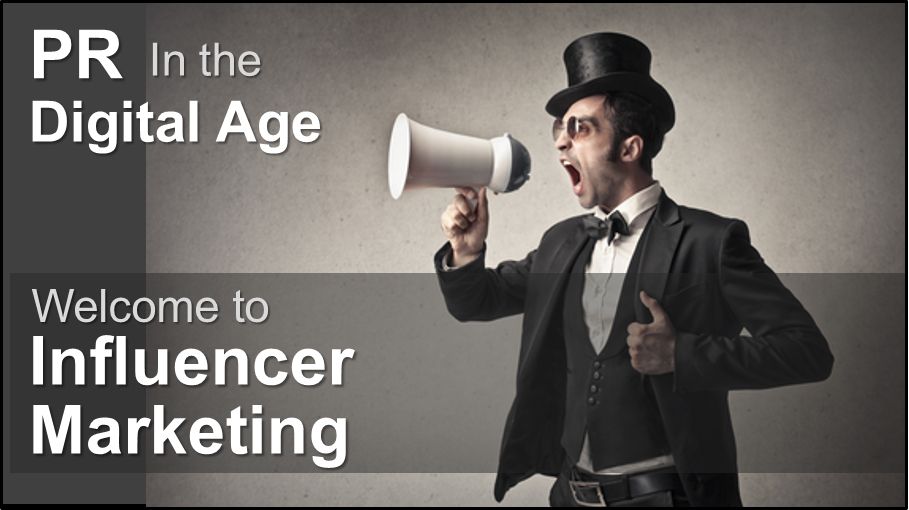Influencer Marketing is difficult and often misunderstood. Let’s start at the begging to understand what it is and how can it help with a marketing strategy.
We all recognize that we live in a world where people consume and share information in a very different way than they did just 10 years ago. There is no need to convince anyone of the impact the internet, social media, and mobile devices have had in business and in life. And still, in most companies, the PR function has not evolved in almost a century.
Only a few years ago, information sources were centralized. People got their news from a handful of newspapers, magazines, and TV stations. Reporters writing for these news outlets were the main source of information. They were, in a sense, a bottleneck or a monopoly in buyer opinion and education. Inside a company, the public relations function was the practice of informing and influencing these reporters with the intention of getting favorable news coverage.
Today, this is an obsolete paradigm as newspapers are moving from print to digital or going out of business. An article printed in this morning’s newspaper is not news anymore, it is history. We learn about the news in real-time via Twitter, Facebook or online news feeds. Millions of amateur and professional writers have become publishers thanks to blogging platforms and other social media channels. Anyone can write news. The problem in the world today is that we have too many news sources, too much to read and too many point of views.
Everyone is empowered to influence. Any really good story can go ‘viral’, spreading faster and broader than what traditional public relations was able do years ago. Good examples include “United Breaks Guitars” and “Comcast Tech Sleeping on my Couch’ which had millions of views, which then resulted in news coverage. In some cases, social news transformed the organizations that were at fault for these incidents.
The Public Relations function needs to evolve
It would be logical then to conclude that the original charter of the public relations function is insufficient in today’s world. A broader lens is required. If PR is the function responsible for influencing opinion through broad reach, a new definition is required, one that takes into account how people form opinion and how information spreads (and is shared).
Recognizing the need to modernize the definition of PR, The Public Relations Society of America (PRSA) crafted a new definition for the practice in 2012. Their new definition states “Public relations is a strategic communication process that builds mutually beneficial relationships between organizations and their publics.” This statement pretty much exemplifies what is wrong with PR today. What a bunch of gobbledy-gook !
The Wikipedia definition of PR can be summarized as spreading information with the goal of persuading around a point of view. I like this one much better, maybe because it is essentially the same I wrote above, ’influencing opinion through broad reach.’
PR as the Pioneer of Influencer Relations
If the true goal of PR is to influence then it needs to evolve into an influencer relations function. The concept of influencers is based on the idea that in almost every market or area of knowledge, there are a small group of people who have a disproportionate ability to influence how people think. This is the concept explored in Malcom Gladwel’s Tipping Point where he classifies influencers as connectors, mavens and salesmen.
It is important to consider why PR needs to focus on a small number of people rather than try to go after the entire public directly. There are two reasons for this. Firstly, this function is about personal relationships or at least personal connections and interactions, which are not scalable. Secondly, reaching masses of people to persuade is what advertising does, in a very impersonal way.
Using this definition, the press is still influential. However, there are other groups of influencers that PR needs to pay attention to (and build ‘mutually beneficial relationships’ with). In today’s world, influencers include the press, bloggers, authors, key customers, industry analysts, and more.
The Three Characteristics of Influencers
What makes someone an influencer? How to identify influencers?
An influencer has a combination of the key factors. The higher these three factors, the higher the influence potential of an individual. The three factors are: Reach, Contextual Credibility and Salesmanship.
- Reach – connections or reach that allows their message and salesmanship to reach many people. A book author or a TV host has an audience, others have twitter or instagram followers.
- Contextual credibility – a unique point of view and perceived knowledge on the particular topic, contextual authority.
- Salesmanship – the ability to influence how people think about an issue.
To build a complete list of the influencers that matter for your organization, one should take a practical approach. Starting with the perspective that a business is trying to sell a product or service, therefore building a list of influencers requires first, an understanding of how customers make purchasing decisions, and second, an understanding of what experts or sources they rely on for making these decisions.
An influencer is someone who helps other people buy from you. This is the simplest definition, and the most practical for marketers.
Advocacy is the goal of Influencer relations
Once these groups of influencers have been identified, and often assigned to people or teams (analyst relations, blogger relations, etc.) and plan to influence, each influencer group must be defined. Influencer marketing usually involves a personal approach that must be focused on helping influencers do their job, satisfy their curiosity, or play to their ego.
Influencers are “turned-on” by empowering them to be advocates. But you can’t buy advocacy (don’t even try). You must be authentic and helpful to earn the opportunity to be listened to by an influencer. You must understand what drives them. How can you help them achieve their goals in the context of your products or services?
Influencers are often driven by status: recognition is more important than monetary rewards. Helping them grow their knowledge is a great way to be helpful. One way to do this is by providing early access to products and the highest levels of expertise in your organization.
Three last points on influence:
- Popularity is not influence. Justin Bieber, Charlie Sheen and Miley Cyrus are popular. They have millions of followers on social networks. And yet, the public is not necessarily going to take advice from them on anything of importance (I sure hope not). Remember, reach, credibility, and salesmanship are required to be an influencer.
- Influence is contextual. Most of my friends will buy a camera I recommend because I have credibility as a good amateur photographer. The same friends would not take my advice on fashion or politics. Influence is determined by the credibility one has in a particular field of knowledge or context.
- Anyone can be an influencer. Passion is the essence of influence. Any person has some level of influence in the areas he or she is passionate about. Someone who is passionate about cooking, for example, will probably build the contextual credibility to be in influencer – limited only by their reach and salesmanship.
Influencer relations is most effective when it works together with other areas of marketing. A good example of influencer relations, media relations, and content marketing working together is the Lumia campaign Nokia is running with National Geographic, where they work with recognized photographers (influencers) and a media property with broad publication (reach) and a reputation for great photography (contextual influence) to promote a product in a very credible way (salesmanship).
What innovative influencer programs have you seen? Please share in the comments.
- Original post published March 2014. Minor updates made in 2016

